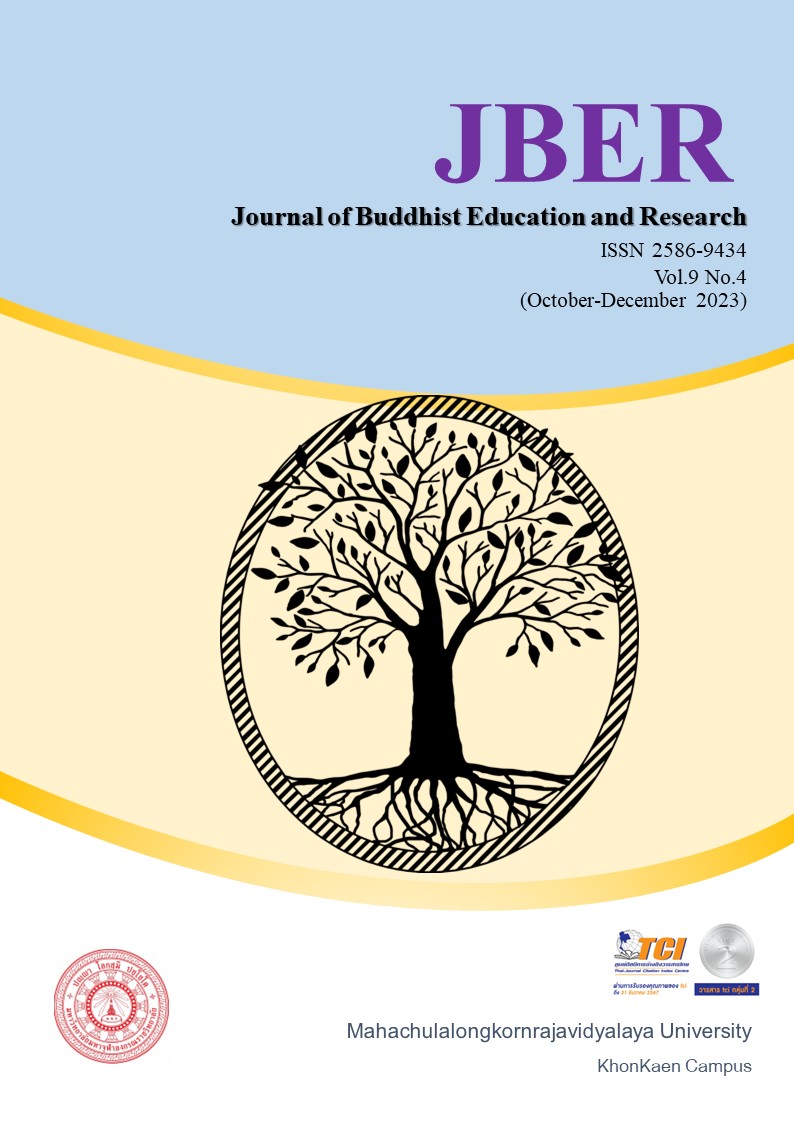ปัจจัยทางเศรษฐกิจที่มีความสัมพันธ์ต่ออัตราแลกเปลี่ยนระหว่างค่าเงินบาทต่อค่าเงิน
Keywords:
Economic Factor; Exchange Rate; Thai Baht; Japan YenAbstract
The purpose of this study was to study the economic factors related to the exchange rate between the baht and the yen. The secondary data was collected from January 1, 2017 to December 31, 2021 for 60 months. There were six types of independent variables used in the study such as Balance of Trade (BOT), Consumer Price Index (CPI), Export Price Index (EPI), International Reserve (IR), Exports to Japan : XJP (XJP), and Real Effective Exchange Rate (REER)
The results showed that the Consumer Price Index (CPI) and International Reserve (IR) showed a statistically significant positive correlation with the baht-yen exchange rate at 0.05; but the Export Price Index (EPI) and the Real Exchange Rate Index (REER) had a statistically significant negative correlation with the exchange rate between the baht and the yen at 0.05 level, and an equation showing the relationship between the variables is as follows; YEN = 68.855 + 0.287CPI - 0.581EPI + 6.802IR - 0.146REER
An R-Squared value of 0.774, indicating that the independent variable used in the equation can be used to describe the dependent variable at 77.40%. But the Balance of Trade (BOT) and Exports to Japan (XJP) are not related to the exchange rate. Therefore, these variables cannot be imported into the equation.
References
กระทรวงพาณิชย์. (2564). อัตราแลกเปลี่ยน. สืบค้นเมื่อ 10 มีนาคม 2565. จาก www.moc.go.th
กรรณิกา ศรีสังข์งาม. (2559). ปัจจัยทางเศรษฐกิจที่กำหนดอัตราแลกเปลี่ยนระหว่างเงินบาทกับเงินหยวน. วารสารรังสิตบัณฑิตศึกษาในกลุ่มธุรกิจและสังคมศาสตร์, 1(2): 81-98.
ทัดพงศ์ อวิโรธนานนท์. (2558). ปัจจัยที่มีผลต่อการเคลื่อนไหวระยะสั้นของอัตราแลกเปลี่ยนค่าเงินบาทต่อเงินเยน. วารสารบริหารธุรกิจ เศรษฐศาสตรและการสื่อสาร, 10(1): 40-49.
ธนาคารแห่งประเทศไทย. (2564). อัตราแลกเปลี่ยน. สืบค้นเมื่อวันที่ 10 มีนาคม 2565. จาก www.bot.or.th
ธัชณรงค์ ธัญญศร. (2559). ความต้องการถือเงินของประเทศไทย ตามกรอบแนวคิดของสำนักการเงินนิยม. วารสารเศรษฐศาสตร์, 18(2): 121-136.
นิภาพร โชติพฤกษวัน. (2554). การศึกษาปัจจัยที่มีผลต่ออัตราแลกเปลี่ยน ค่าเงินบาทต่อดอลลาร์สหรัฐฯค่าเงินบาทต่อยูโร และค่าเงินบาทต่อหยวน. การค้นคว้าอิสระหลักสูตรบริหารธุรกิจมหาบัณฑิต สาขาวิชาการเงิน. มหาวิทยาลัยหอการค้าไทย.
พรรณวดี เลิศลุมพลีพันธุ์. (2564). ปัจจัยทางเศรษฐกิจที่ส่งผลต่อการเปลี่ยนแปลงอัตราแลกเปลี่ยนเงินบาทต่อเงินสกุลยูโร. วารสารมนุษยศาสตร์และสังคมศาสตร์ มหาวิทยาลัยธนบุรี, (2): 126-136.
หทัยชนก คงพูลศิลป์. (2564). การศึกษาความสัมพันธ์ระหว่างราคาทองคํา ราคาน้ำมัน อัตราแลกเปลี่ยน และผลตอบแทนของตลาดทุนในประเทศสหรัฐอเมริกาและประเทศญี่ปุ่น. สารนิพนธ์หลักสูตรปริญญาการจัดการมหาบัณฑิต. มหาวิทยาลัยมหิดล.
วารี ชัยเสรี. (2554). ผลกระทบของความผันผวนของอัตราแลกเปลี่ยนต่อการส่งออกสินค้าเกษตรที่สำคัญ. ปริญญานิพนธ์หลักสูตรปริญญาเศรษฐศาสตรมหาบัณฑิต. สาขาเศรษฐศาสตร์การจัดการ. มหาวิทยาลัยศรีนครินทรวิโรฒ.
ศิริรัตน์ อุทุมทอง. (2561). ปัจจัยที่มีอิทธิพลต่ออัตราแลกเปลี่ยนเงินบาทไทยต่อดอลลาร์สหรัฐฯ เงินบาทไทยต่อเงินเยน และเงินบาทไทยต่อเงินยูโร. สืบค้นเมื่อ 10 มกราคม 2565, จาก
สมยศ อวเกียรติ. (2559). อิทธิพลของปัจจัยที่สำคัญต่ออัตราแลกเปลี่ยนเงินบาทต่อดอลลาร์สหรัฐฯ เงินบาท ต่อยูโร และ เงินบาทต่อเยน. วารสารวิชาการบริหารธุรกิจ, 5(2): 16-27.
สาริศ นาถะภักติ. (2560). ปัจจัยทางเศรษฐกิจที่มีความสัมพันธ์ต่ออัตราแลกเปลี่ยนค่าเงินจัตต่อค่าเงินบาท. การค้นคว้าอิสระหลักสูตรวิทยาศาสตรมหาบัณฑิต สาขาวิชาการบริหารการเงิน. มหาวิทยาลัยธรรมศาสตร์.
อารมย์ โกวิชัย. (2559). ปัจจัยทางเศรษฐกิจไทยที่มผลกระทบต่ออัตราการเปลี่ยนแปลงของอัตราแลกเปลี่ยนระหว่างค่าเงินบาทต่อดอลลาร์สหรัฐอเมริกา. คณะบริหารธุรกิจ มหาวิทยาลัยหอการค้าไทย.
Lin, C. H. (2011). Exchange Rate Exposure in the Asian Emerging Markets. Journal of Multinational Financial Management, 21, 224-238. doi:10.1016/j.mulfin.2011.04.002
Hammoudeh, S., & McAleer, M. (2013). Risk management and financial derivatives: An overview. The North American Journal of Economics and Finance, 25:109-115.
Nguyen, Q. N., Bedoui, R., Majdoub, N., Guesmi, K., & Chevallier, J. (2020). Hedging and safe-haven characteristics of Gold against currencies: An investigation based on multivariate dynamic copula theory. Resources Policy, 68, 101766.





